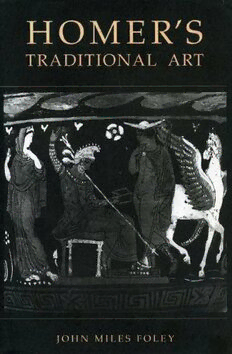
Homer’s Traditional Art PDF
Preview Homer’s Traditional Art
H O M E R ' S TRADITIONAL ART J O H N MILES FOLEY H O M E R ' S T R A D I T I O N A L ART Library of Congress Cataloging-in-Publication Data Foley, John Miles, 1947- Homer's traditional art / John Miles Foley. p. cm. Includes bibliographical references and index. ISBN 0-271-01870-4 (alk. paper) 1. Homer-Technique. 2. Epic poetry, Greek-History and criticism. 3. Oral-formulaic analysis. 4. Oral tradition-Greece. 5. Rhetoric, Ancient. I. Title. PA4175.F65 1999 883'.01-dc21 98-51850 CIP Copyright O 1999 The Pennsylvania State University All rights reserved Published by The Pennsylvania State University Press, University Park, PA 16802-1003 It is the policy of The Pennsylvania State University Press to use acid-free paper for the first printing of all clothbound books. Publications on uncoated stock sat- isfy the minimum requirements of American National Standard for Information Sciences-Permanence of Paper for Printed Library Materials, ANSI 239.48-1992. To the memory of Hannah Frances Foley Kelly For all my days remaining "To Homer" John Keats Standing aloof in giant ignorance, Of thee I hear and of the Cyclades, As one who sits ashore and longs perchance To visit dolphin-coral in deep seas. So thou wast blind;-but then the veil was rent, For Jove uncurtain'd heaven to let thee live, And Neptune madefor thee a spumy tent, And Pan made sing for thee his forest-hive; Aye on the shores of darkness there is light, And precipices show untrodden green, There is a budding morrow in midnight, There is a triple sight in blindness keen; Such seeing hadst thou, as it once befel To Dian, Queen of Earth, and Heaven, and Hell. CONTENTS Pronunciation Key ix Preface xi Introduction 1 PART I: HOMER'S SIGN-LANGUAGE 1 Homeric Signs and Traditional Referentiality 13 PART II: HOMERIC AND SOUTH SLAVIC EPIC 2 Homer and the South Slavic Guslar: The Analogy and the Singers 37 3 Homer and the South Slavic Guslar: Traditional Register 65 4 Homer and the South Slavic Guslar: Traditional Referentiality 89 PART III: READING HOMER'S SIGNS 5 Story-Pattern as Sêma: The Odyssey as a Return Song 115 6 Typical Scenes of Feast and Lament 169 7 Word, Idiom, Speech-Act: The Traditional Phrase as Sêma 201 PART IV: HOMERIC SIGNS AND ODYSSEY 23 8 Rereading Odyssey 23 241 Afterword: "Deor" and Anglo-Saxon Sêmata 263 Appendix I. Feasting in Homer 271 Appendix II. "Deor" 275 Notes 277 Master Bibliography 321 Index 341 Index Locorum 357 This page intentionally left blank PRONUNCIATION KEY To make the experience of South Slavic epic more realistic, I offer the following brief pronunciation key, intended for the nonspecialist. The reader may use it to approximate the sound of singers' and characters' names, for example, or of various traditional phrases in the original lan- guage; these occur chiefly in Chapters 2-5. All instances of South Slavic language in this book are set in the Latin alphabet, with the customary dia- critics, rather than in the Cyrillic alphabet, regardless of which system was used for initial publication (if any). Both of these alphabets, regu- larized by the great collector and linguist Vuk Karadiit in the mid- nineteenth century, are entirely phonetic. For more specific information, see Magner 1972. Consonants pronounced approximately like their English counterparts: b, d, f, g (hard, as in "get"), k, 1, m, n, p, s, t, v, z Consonants without direct English counterparts: [ts], as in rats [tch], ch pronounced at the front of the mouth [ch], ch pronounced further back in the mouth, as in chair [y], as in toy or yes [dy], as in the phrase and you [ly], as in million [ny], as in the phrase on your similar to English, but rougher, more aspirated (like German ch) [sh], as in show [zh], as in azure [j], as in judge trilled or rolled sound, as in three in some British dialects; often in Spanish
